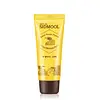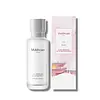What's inside
What's inside
 Key Ingredients
Key Ingredients

 Benefits
Benefits

 Ingredients Side-by-side
Ingredients Side-by-side

Honey Extract 40%
HumectantWater
Skin ConditioningAloe Barbadensis Leaf Juice
Skin ConditioningGlycerin
HumectantGlycereth-26
HumectantHyaluronic Acid
HumectantSorbitol
HumectantPropolis Extract
Skin ConditioningRoyal Jelly Extract
Skin ConditioningSh-Oligopeptide-1
Skin ConditioningSh-Polypeptide-11
Oligopeptide-2
Skin ConditioningHydrolyzed Collagen
EmollientBeta-Glucan
Skin ConditioningPortulaca Oleracea Extract
Skin ConditioningOriganum Vulgare Leaf Extract
Skin ConditioningCaffeoyl Tripeptide-1
AntioxidantChamomilla Recutita Flower Extract
MaskingGlycine Max Seed Extract
Skin ConditioningScutellaria Baicalensis Root Extract
AstringentButylene Glycol
HumectantSucrose
HumectantFructose
HumectantGlucose
HumectantTrehalose
HumectantPanthenol
Skin ConditioningDipotassium Glycyrrhizate
HumectantAllantoin
Skin ConditioningGlucosylrutin
AntioxidantArginine
MaskingCarbomer
Emulsion StabilisingXanthan Gum
Emulsifying1,2-Hexanediol
Skin ConditioningHoney Extract 40%, Water, Aloe Barbadensis Leaf Juice, Glycerin, Glycereth-26, Hyaluronic Acid, Sorbitol, Propolis Extract, Royal Jelly Extract, Sh-Oligopeptide-1, Sh-Polypeptide-11, Oligopeptide-2, Hydrolyzed Collagen, Beta-Glucan, Portulaca Oleracea Extract, Origanum Vulgare Leaf Extract, Caffeoyl Tripeptide-1, Chamomilla Recutita Flower Extract, Glycine Max Seed Extract, Scutellaria Baicalensis Root Extract, Butylene Glycol, Sucrose, Fructose, Glucose, Trehalose, Panthenol, Dipotassium Glycyrrhizate, Allantoin, Glucosylrutin, Arginine, Carbomer, Xanthan Gum, 1,2-Hexanediol
Portulaca Oleracea Extract
Skin ConditioningBetula Alba Bark Extract
MaskingOryza Sativa Bran Extract
Skin ConditioningButylene Glycol
Humectant1,2-Hexanediol
Skin ConditioningGlycerin
HumectantCaprylic/Capric Triglyceride
MaskingTriethylhexanoin
MaskingGlycereth-26
HumectantHydrogenated Polydecene
EmollientHydroxyethyl Acrylate/Sodium Acryloyldimethyl Taurate Copolymer
Emulsion StabilisingSodium Hyaluronate
HumectantBetaine
HumectantAllantoin
Skin ConditioningCitrus Aurantium Bergamia Fruit Oil
MaskingPanthenol
Skin ConditioningMadecassoside
AntioxidantAsiaticoside
AntioxidantCeramide NP
Skin ConditioningMagnesium Ascorbyl Phosphate
AntioxidantBeta-Glucan
Skin ConditioningChamomilla Recutita Flower Extract
MaskingZanthoxylum Piperitum Fruit Extract
Skin ConditioningPulsatilla Koreana Extract
Skin ConditioningUsnea Barbata Extract
Adenosine
Skin ConditioningC14-22 Alcohols
Emulsion StabilisingC12-20 Alkyl Glucoside
EmulsifyingDisodium EDTA
Water
Skin ConditioningGlucose
HumectantPortulaca Oleracea Extract, Betula Alba Bark Extract, Oryza Sativa Bran Extract, Butylene Glycol, 1,2-Hexanediol, Glycerin, Caprylic/Capric Triglyceride, Triethylhexanoin, Glycereth-26, Hydrogenated Polydecene, Hydroxyethyl Acrylate/Sodium Acryloyldimethyl Taurate Copolymer, Sodium Hyaluronate, Betaine, Allantoin, Citrus Aurantium Bergamia Fruit Oil, Panthenol, Madecassoside, Asiaticoside, Ceramide NP, Magnesium Ascorbyl Phosphate, Beta-Glucan, Chamomilla Recutita Flower Extract, Zanthoxylum Piperitum Fruit Extract, Pulsatilla Koreana Extract, Usnea Barbata Extract, Adenosine, C14-22 Alcohols, C12-20 Alkyl Glucoside, Disodium EDTA, Water, Glucose
 Reviews
Reviews

Ingredients Explained
These ingredients are found in both products.
Ingredients higher up in an ingredient list are typically present in a larger amount.
1,2-Hexanediol is a synthetic liquid and another multi-functional powerhouse.
It is a:
- Humectant, drawing moisture into the skin
- Emollient, helping to soften skin
- Solvent, dispersing and stabilizing formulas
- Preservative booster, enhancing the antimicrobial activity of other preservatives
Allantoin is a soothing ingredient known for its protective and moisturizingg properties. Because of this, it is often added to products with strong active ingredients.
Studies show higher concentrations of this ingredient can promote wound healing.
Though it can be derived from the comfrey plant, allantoin is produced synthetically for cosmetic products to ensure purity.
Learn more about AllantoinBeta-Glucan is a polysaccharide. It can be derived from the cell walls of seaweed, oats, yeast, and fungi. It hydrates the skin and helps boost your skin's natural barrier.
As an antioxidant, beta-glucan helps fight free-radicals. Free-radicals are molecules that may damage your skin cells, such as pollution.
Studies show this ingredient may be an effective wrinkle reducer as it can deeply penetrate into skin. It has also been show to help with wound healing.
Learn more about Beta-GlucanButylene Glycol (or BG) is used within cosmetic products for a few different reasons:
Overall, Butylene Glycol is a safe and well-rounded ingredient that works well with other ingredients.
Though this ingredient works well with most skin types, some people with sensitive skin may experience a reaction such as allergic rashes, closed comedones, or itchiness.
Learn more about Butylene GlycolChamomilla Recutita Flower Extract comes from the Chamomile flower.
Chamomile is rich in antioxidants and has anti-inflammatory properties. Several compounds found in chamomile help with soothing, such as bisbolol.
Antioxidant components in chamomile make it an effective ingredient to help slow the signs of aging. Antioxidants help fight free-radical molecules, or molecules that may damage your skin.
Essential oils from chamomile have been found to improve wound healing due to its antimicrobial properties.
Ancient Greeks and Egyptians used Chamomile to treat skin redness and dryness. Chamomile has also been used to help treat stomach issues.
Learn more about Chamomilla Recutita Flower ExtractGlucose is a simple sugar and is the most important source of energy in all organisms.
In skincare, glucose is used to hydrate the skin. It also acts as a prebiotic for our natural biome.
Glucose is hydrating due to its humectant property. As a humectant, glucose draws moisture from the air and from deeper levels in the skin.
Our skin contains many sugars that act as prebiotics and help strengthen our natural microbiome. Having a healthy microbiome helps protect our skin from harmful bacteria and other contaminants.
Studies show glucose may help with fading discoloration and pigmentation. This is because our skin metabolizes glucose into lactic acid. Lactic acid is an AHA that helps exfoliate the top layer of skin.
Learn more about GlucoseGlycereth-26 is a synthetic ingredient and polyethylene glycol ether of Glycerin. Glycerin is already naturally found in your skin and helps keep your skin moisturized.
It is a humectant and helps add texture to products. It can make your product thicker.
As a humectant, it helps draw moisture from the air to your skin. This helps your skin stay hydrated.
Learn more about Glycereth-26Glycerin is already naturally found in your skin. It helps moisturize and protect your skin.
A study from 2016 found glycerin to be more effective as a humectant than AHAs and hyaluronic acid.
As a humectant, it helps the skin stay hydrated by pulling moisture to your skin. The low molecular weight of glycerin allows it to pull moisture into the deeper layers of your skin.
Hydrated skin improves your skin barrier; Your skin barrier helps protect against irritants and bacteria.
Glycerin has also been found to have antimicrobial and antiviral properties. Due to these properties, glycerin is often used in wound and burn treatments.
In cosmetics, glycerin is usually derived from plants such as soybean or palm. However, it can also be sourced from animals, such as tallow or animal fat.
This ingredient is organic, colorless, odorless, and non-toxic.
Glycerin is the name for this ingredient in American English. British English uses Glycerol/Glycerine.
Learn more about GlycerinPanthenol is a common ingredient that helps hydrate and soothe the skin. It is found naturally in our skin and hair.
There are two forms of panthenol: D and L.
D-panthenol is also known as dexpanthenol. Most cosmetics use dexpanthenol or a mixture of D and L-panthenol.
Panthenol is famous due to its ability to go deeper into the skin's layers. Using this ingredient has numerous pros (and no cons):
Like hyaluronic acid, panthenol is a humectant. Humectants are able to bind and hold large amounts of water to keep skin hydrated.
This ingredient works well for wound healing. It works by increasing tissue in the wound and helps close open wounds.
Once oxidized, panthenol converts to pantothenic acid. Panthothenic acid is found in all living cells.
This ingredient is also referred to as pro-vitamin B5.
Learn more about PanthenolThis extract comes from Purslane, a succulent. It has anti-inflammatory, antioxidant, and hydrating properties.
Purslane is very nutritious. It contains omega-3 fatty acids, NMFs, many vitamins, minerals, and antioxidants. The vitamins found in purslane include: Vitamin C, Vitamin A, and Vitamin E.
Fun fact: Purslane is a succulent with an extensive habitat. It is used in traditional Korean medicine to treat irritated skin.
Nowadays, purslane is becoming a superfood due to its highly nutritious content.
Learn more about Portulaca Oleracea ExtractWater. It's the most common cosmetic ingredient of all. You'll usually see it at the top of ingredient lists, meaning that it makes up the largest part of the product.
So why is it so popular? Water most often acts as a solvent - this means that it helps dissolve other ingredients into the formulation.
You'll also recognize water as that liquid we all need to stay alive. If you see this, drink a glass of water. Stay hydrated!
Learn more about Water